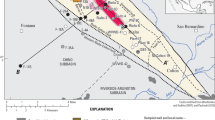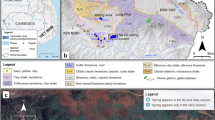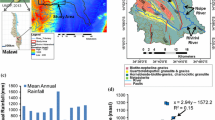Abstract
Potassium chloride (KCl) and potassium bromide (KBr) tracers were used to explore the role of geologic structure on groundwater recharge and flow at the Fractured Rock Research Site in Floyd County, Virginia, USA. Tracer migration was monitored through soil, saprolite, and fractured crystalline bedrock for a period of 3 months with chemical, physical, and geophysical techniques. The tracers were applied at specific locations on the ground surface to directly test flow pathways in a shallow saprolite and deep fractured-rock aquifer. Tracer monitoring was accomplished with differential electrical resistivity, chemical sampling, and physical monitoring of water levels and spring discharge. KCl, applied at a concentration of 10,000 mg/L, traveled 160 m downgradient through the thrust fault aquifer to a spring outlet in 24 days. KBr, applied at a concentration of 5,000 mg/L, traveled 90 m downgradient through the saprolite aquifer in 19 days. Tracer breakthrough curves indicate diffuse flow through the saprolite aquifer and fracture flow through the crystalline thrust fault aquifer. Monitoring saline tracer migration through soil, saprolite, and fractured rock provided data on groundwater recharge that would not have been available using other traditional hydrologic methods. Travel times and flowpaths observed during this study support preferential groundwater recharge controlled by geologic structure.
Résumé
Les traceurs de chlorure de potassium (KCl) et bromure de potassium (KBr) ont été utilisés pour explorer l’impact de la structure géologique sur la recharge et l’écoulement de l’eau souterraine au Site de Recherche sur les Roches Fracturées dans le comté de Floyd en Virginie aux USA. La migration du traceur a été surveillée dans le sol, le saprolite et le socle cristallin fracturé sur une période de 3 mois au moyen de techniques chimiques, physiques et géophysiques. Les traceurs ont été injectés à la surface du sol, en des lieux spécifiquement choisis pour évaluer directement les lignes d’écoulement dans un saprolite peu profond et un aquifère de roche fracturée profond. La surveillance des traceurs a été réalisée au moyen de résistivité électrique différentielle, échantillonnage chimique et surveillance physique des niveaux d’eau et du débit des sources. Le KCl, injecté à une concentration de 10, 000 mg/L, a parcouru en 24 jours 160 m en aval à travers l’aquifère affecté par la faille inverse jusqu′à l’exutoire d’une source. Le KBr, injecté à une concentration de 5, 000 mg/L, a transité sur 90 m à travers l’aquifère de saprolite en 19 jours. Les courbes de restitution des traceurs indiquent un écoulement diffus à travers l’aquifère de saprolite et un écoulement de fracture à travers l’aquifère de socle cristallin affecté par la faille inverse. La surveillance de la migration du traceur salin à travers le sol, le saprolite et la roche fracturée a apporté des données sur la recharge de l’eau souterraine qui n’auraient pas été disponibles via d’autres méthodes hydrologiques. Les temps de transport et les directions d’écoulement observés durant cette étude étayent l’idée d’une recharge préférentielle contrôlée par la structure géologique.
Resumen
Mediante la utilización de cloruro potásico (KCl) y bromuro potásico (KBr), se ha investigado el papel de la estructura geológica en la recarga y flujo del agua subterránea en el punto de Investigación de rocas fracturadas en Floyd County, Virginia, USA. La migración de los trazadores se ha monitorizado a través del suelo, el saprolito y las rocas cristalinas fracturadas durante 3 meses mediante técnicas químicas, físicas y geofísicas. Los trazadores se aplicaron en sitios específicos de la superficie del suelo para testar directamente los flujos de agua en el saprolito superficial y el acuífero profundo en rocas fracturadas. La monitorización de los trazadores se acompañó de medidas de resistividad eléctrica diferencial, muestreo químico y monitorización física de los niveles de agua y la descarga en manantiales. KCl, aplicado en una concentración de 10,000 mg/L, viajó 160 m aguas abajo a través del acuífero hacia un manantial en 24 días. KBr, aplicado con una concentración de 5,000 mg/L, viajó aguas abajo 90 m a través de acuífero en el saprolito durante 19 días. Las curvas de la llegada de los trazadores indican la existencia de flujo difuso a través del saprolito y el flujo a través de fracturas del acuífero cristalino fallado. Monitorizando los trazadores salinos a través del suelo, el saprolito y la roca fracturada se consiguen datos de la recarga que no serían obtenidos usando otros métodos hidrológicos tradicionales. Los tiempos de residencia y los caminos del flujo observados durante este estudio apuntan a la existencia de recarga de agua subterránea por flujos preferenciales controlados por la estructura geológica.






Similar content being viewed by others
References
AGI (2006) Instruction Manual for EarthImager 2D: Resistivity and IP Inversion Software. Advanced Geosciences Inc., Palo Verdes Estates, CA
Buol SW, Amoozegar A, Vepraskas MJ (2000) Physical, chemical, and morphological properties of some regoliths in North Carolina. Southeast Geol 39:151–160
Daniel CC (1996) Groundwater recharge to the regolith-fractured crystalline rock aquifer system, Orange County, North Carolina. US Geol Surv Water Resour Invest Rep 96-4220, pp 67
Derby NE, Knighton RE (2001) Field-scale preferential transport of water and chloride tracer by depression-focused recharge. J Environ Qual 30(1):194–199
Dietrich RV (1970) Geology and Virginia. University Press of Virginia, Charlottesville, VA
Dyck MF, Kachanoski RG, de Jong E (2005) Spatial variability of long-term chloride transport under semiarid conditions: pedon scale. Vadose Zone J 4(4):915–923
Gentry WM, Burbey TJ (2004) Characterization of ground water flow from spring discharge in a crystalline rock environment. J Am Water Resour Assoc 40(5):1205–1217
Heath RC (1984) Ground-water reigons of the United States. US Geol Surv Water Suppl Pap 2242, pp 78
Hu Q, Moran JE (2005) Simultaneous analyses and applications of multiple fluorobenzoate and halide tracers in hydrologic studies. Hydrol Process 19(14):2671–2687
Käss W (1998) Tracing technique in geohydrology. Balkema, Rotterdam
Kim JW, Choi H, Lee JY (2005) Characterization of hydrogeologic properties for a multi-layered alluvial aquifer using hydraulic and tracer tests and electrical resistivity survey. Environ Geol 48(8):991–1001
Legrand HE (2004) A master conceptual model for hydrogeological site characterization in the piedmont and mountain region of North Carolina: a guidance manual. North Carolina Department of Environment and Natural Resources, Raleigh, NC, 55 pp
Levitt DG, Newell DL, Stone WJ, Wykoff DS (2005) Surface water-groundwater connection at the Los Alamos Canyon Weir Site: part 1, monitoring site installation and tracer tests. Vadose Zone J 4(3):708–717
Levy BS, Chambers RM (1987) Bromide as a conservative tracer for soil-water studies. Hydrol Process 1(4):385–389
Seaton WJ, Burbey TJ (2000) Aquifer characterization in the Blue Ridge physiographic province using resistivity profiling and borehole geophysics: geologic analysis. J Environ Eng Geophys 5(3):45–58
Seaton WJ, Burbey TJ (2002) Evaluation of two-dimensional resistivity methods in a fractured crystalline-rock terrane. J Appl Geophys 51(1):21–41
Seaton WJ, Burbey TJ (2005) Influence of ancient thrust faults on the hydrogeology of the Blue Ridge Province. Ground Water 43(3):301–313
Singha K, Gorelick SM (2005) Saline tracer visualized with three-dimensional electrical resistivity tomography: field-scale spatial moment analysis. Water Resour Res 41(5), W05023. DOI 10.1029/2004WR003460
Singha K, Binley AM, Lane JW Jr, Gorelick SM (2003) Electrical imaging of tracer migration at the Massachusetts Military Reservation, Cape Cod. Symposium on the Application of Geophysics to Engineering and Environmental Problems (SAGEEP), Environmental and Engineering Geophysical Society, San Antonia, Texas, 6–10 April 2003
Slater L, Binley AM, et al (1997) Electrical imaging of saline tracer migration for the investigation of unsaturated zone transport mechanisms. Hydrol Earth Sys Sci 1(2):291–302
Slater L, Binley AM, Daily W, Johnson R (2000) Cross-hole electrical imaging of a controlled saline tracer injection. J Appl Geophys 44(2–3):85–102
Swain LA, Mesko TO, Zaidman MD, West LJ (2004) Summary of the hydrogeology of the Valley and Ridge, Blue Ridge, and Piedmont physiographic provinces in the eastern United States. US Geol Surv Prof Pap 1422-A, 23 pp
Vanderborght J, Vereecken H (2001) Analyses of locally measured bromide breakthrough curves from a natural gradient tracer experiment at Krauthausen. J Contam Hydrol 48(1–2):23–43
Virginia Department of Environmental Quality (2003) Virginia Drought Assessment and Response Plan. Virginia Department of Environmental Quality, Richmond, VA, 23 pp
Weaver JC (2005) The drought of 1998–2002 in North Carolina: precipitation and hydrologic conditions. US Geol Surv Sci Invest Rep 2005-5053, 88 pp
White BA, Burbey TJ (2007) Evidence for structurally controlled recharge in the Blue Ridge Province, Virginia, USA. Hydrogeol J 15(5):929–943
Acknowledgements
The authors express appreciation to the Virginia Department of Environmental Quality for their financial support and to Mr. Lynwood Drake for use of his property for this research. The authors would also like to thank Dr. Timothy Bechtel and two anonymous reviewers for their thoughtful and beneficial comments that greatly improved the manuscript.
Author information
Authors and Affiliations
Corresponding author
Rights and permissions
About this article
Cite this article
Rugh, D.F., Burbey, T.J. Using saline tracers to evaluate preferential recharge in fractured rocks, Floyd County, Virginia, USA. Hydrogeol J 16, 251–262 (2008). https://doi.org/10.1007/s10040-007-0236-3
Received:
Accepted:
Published:
Issue Date:
DOI: https://doi.org/10.1007/s10040-007-0236-3




